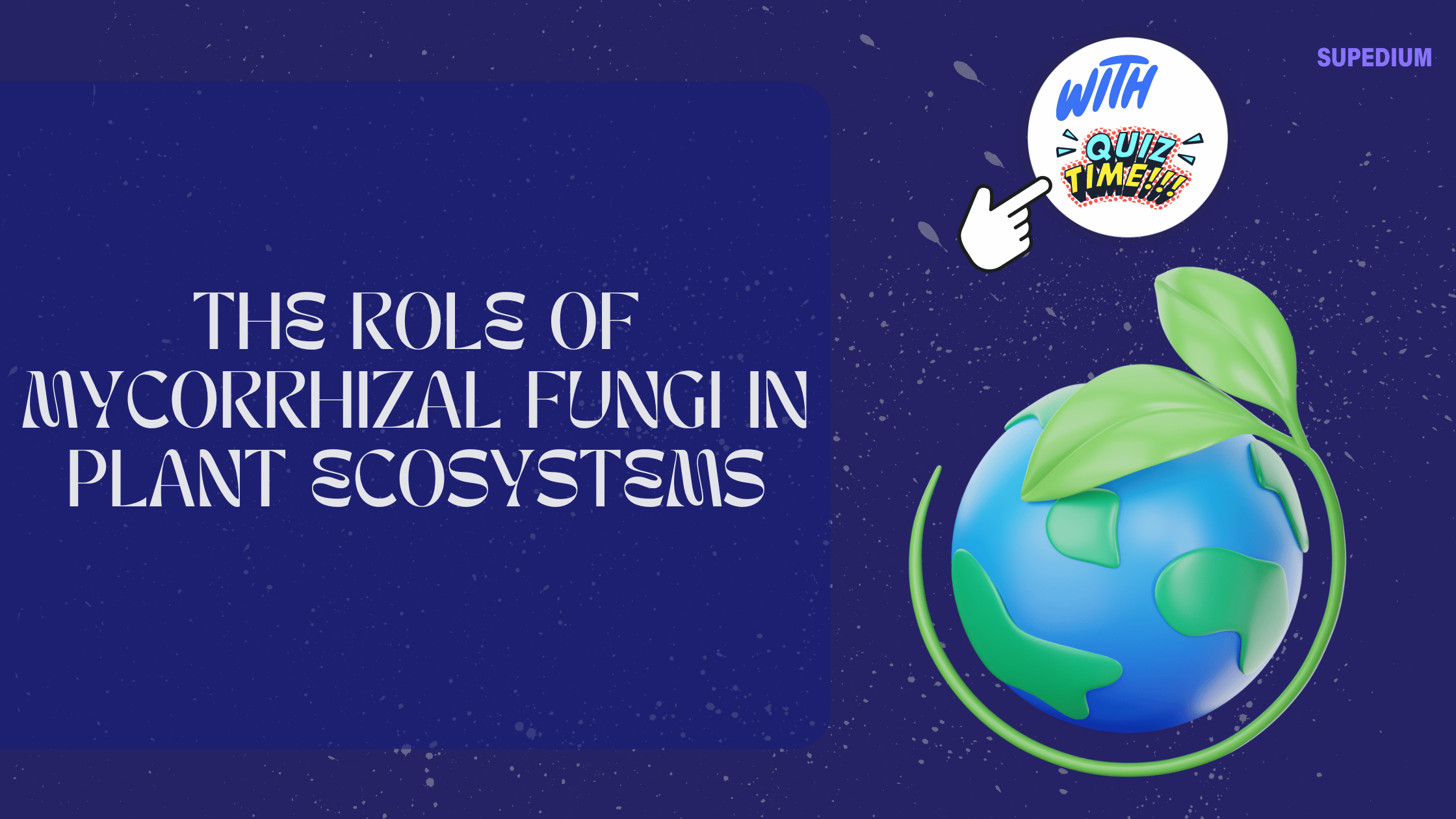Table of Contents
![]()
Introduction
Definition of Mycorrhizal Fungi
Mycorrhizal fungi are a diverse group of fungi that form symbiotic associations with plant roots. The term “mycorrhiza” derives from Greek, meaning “fungal root.” This symbiotic relationship is crucial for plant health and ecosystem functioning. Mycorrhizae are classified into several types based on their interaction with plant roots, including ectomycorrhizae, endomycorrhizae, and other less common forms.
Importance of Mycorrhizal Fungi in Ecosystems
Mycorrhizal fungi play an essential role in plant ecosystems, contributing significantly to nutrient uptake, soil health, and ecosystem dynamics. Their interactions with plants enhance agricultural productivity, support forest ecosystems, and influence natural habitats. Understanding their role is vital for improving crop yields, forest management, and overall ecosystem sustainability.
Types of Mycorrhizal Associations
Ectomycorrhizae
Ectomycorrhizae form a sheath around the outside of plant roots and penetrate between root cells but do not invade the cells themselves. This type of mycorrhiza is commonly associated with woody plants, particularly in temperate and boreal forests. The fungi involved in ectomycorrhizal associations include species from the genera Amanita, Boletus, and Cortinarius. These fungi enhance nutrient uptake, especially phosphorus, and improve plant resistance to pathogens.
Endomycorrhizae (Arbuscular Mycorrhizae)
Endomycorrhizae, or arbuscular mycorrhizae, penetrate plant root cells, forming structures known as arbuscules and vesicles. This type of mycorrhiza is the most widespread and is found in approximately 80% of terrestrial plant species. The fungi involved are primarily from the phylum Glomeromycota. Endomycorrhizae play a crucial role in phosphorus uptake and can also assist in acquiring other nutrients, such as nitrogen and zinc.
Other Types
- Ericoid Mycorrhizae: These are typically found in acidic and nutrient-poor soils, forming associations with plants in the family Ericaceae, such as heathers and blueberries. They help plants acquire nutrients from otherwise inaccessible sources.
- Orchid Mycorrhizae: Orchids rely on mycorrhizal fungi during their early stages of development. These fungi provide essential nutrients to the orchid seeds, which lack the capability to photosynthesize until they are established.
Symbiotic Relationship between Mycorrhizal Fungi and Plants
Nutrient Exchange
Mycorrhizal fungi significantly enhance nutrient acquisition for plants. The fungi’s extensive hyphal networks explore a larger volume of soil than plant roots alone, facilitating the uptake of nutrients, especially phosphorus, which is often limited in soils. In return, plants provide fungi with carbohydrates produced through photosynthesis, establishing a mutually beneficial exchange.
Water Relations
Mycorrhizal associations improve plant water uptake by increasing the root surface area and enhancing soil structure. This improved access to water can increase plant drought tolerance, allowing plants to survive and thrive under water-limited conditions. The fungal hyphae act as a bridge between the plant roots and the soil moisture, helping to mitigate the effects of drought.
Plant Growth and Health
Plants with mycorrhizal associations often exhibit improved growth rates, greater biomass, and increased resistance to diseases. The enhanced nutrient and water uptake contribute to overall plant vigor and health. Additionally, mycorrhizal fungi can interact with other soil microbes, potentially suppressing harmful pathogens and fostering a more balanced soil microbiome.
Ecological Roles of Mycorrhizal Fungi
Soil Structure and Health
Mycorrhizal fungi contribute to soil health by promoting soil aggregation and improving soil structure. The hyphae of mycorrhizal fungi help bind soil particles together, enhancing soil stability and reducing erosion. Additionally, mycorrhizae play a role in the decomposition of organic matter, contributing to soil fertility and nutrient cycling.
Biodiversity and Ecosystem Function
Mycorrhizal fungi influence plant community composition and diversity by affecting nutrient availability and competition. They can also affect ecological succession, aiding in the establishment of plant communities in disturbed or degraded areas. By supporting diverse plant communities, mycorrhizal fungi contribute to overall ecosystem resilience and functionality.
Carbon Cycling
Mycorrhizal fungi play a role in carbon cycling by facilitating the transfer of carbon from plants to the soil. Fungal hyphae help secrete organic compounds into the soil, contributing to soil organic carbon stocks. This process is important for carbon sequestration and mitigating greenhouse gas emissions, making mycorrhizal fungi crucial players in climate change mitigation efforts.
Mycorrhizal Fungi in Agriculture and Forestry
Agricultural Practices
In agriculture, mycorrhizal inoculants are used to enhance crop production. These inoculants help improve nutrient uptake, particularly phosphorus, and can also enhance plant resistance to environmental stresses. The use of mycorrhizal fungi in sustainable agriculture promotes soil health and reduces the need for chemical fertilizers.
Forest Management
Mycorrhizal fungi are integral to forest ecosystems, contributing to forest regeneration and productivity. They support nutrient cycling, enhance tree growth, and contribute to the health of forest soils. Effective forest management practices that consider mycorrhizal health can lead to more resilient and productive forest ecosystems.
Threats and Challenges
Anthropogenic Impacts
Human activities, such as deforestation, pollution, and climate change, pose threats to mycorrhizal fungi and their ecosystems. Changes in land use and environmental conditions can disrupt fungal communities, affecting plant health and ecosystem stability. Addressing these impacts is essential for maintaining healthy mycorrhizal associations and ecosystem functioning.
Conservation and Management
Protecting mycorrhizal fungi involves conserving natural habitats, reducing pollution, and implementing sustainable land management practices. Efforts to preserve fungal biodiversity and maintain healthy mycorrhizal communities are crucial for ecosystem stability and resilience. Research and monitoring are needed to better understand and mitigate the threats to these important organisms.
Future Research Directions
Advances in Mycorrhizal Biology
Ongoing research in mycorrhizal biology is exploring new technologies and methods for studying these fungi. Advances in genomics, metagenomics, and imaging techniques are providing deeper insights into fungal functions, interactions, and contributions to ecosystems. These advancements will enhance our understanding and ability to manage mycorrhizal fungi effectively.
Applications and Innovations
Future research may uncover new applications for mycorrhizal fungi in biotechnology, restoration ecology, and climate change mitigation. Innovations in the use of mycorrhizal inoculants, fungal-based bioremediation, and carbon sequestration strategies could offer novel solutions to environmental challenges and enhance ecosystem sustainability.
Conclusion
Summary of Key Points
Mycorrhizal fungi play a critical role in plant ecosystems, providing essential benefits for nutrient uptake, soil health, and ecosystem functioning. Their symbiotic relationships with plants enhance growth, resilience, and productivity, contributing to the overall health of natural and managed ecosystems.
Implications for Ecosystem Management and Conservation
Maintaining healthy mycorrhizal communities is crucial for effective ecosystem management and conservation. By understanding and supporting the role of mycorrhizal fungi, we can promote sustainable agriculture, forest management, and biodiversity conservation. Continued research and informed management practices will be key to preserving these vital organisms and the ecosystems they support.






Be the first to comment